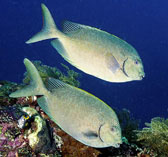| Family: |
Siganidae (Rabbitfishes) |
| Max. size: |
40 cm TL (male/unsexed) |
| Environment: |
reef-associated; marine; depth range 1 - 40 m |
| Distribution: |
Western Pacific: fringe of the eastern sector of the Indian Ocean, Cocos (Keeling) Islands, Australia, Indonesia, Singapore, Gulf of Thailand, South China Sea, Philippines, Taiwan, Ryukyu Islands, Ogasawara Islands, Mariana Islands, Palau (Belau), Caroline Islands, Kapingamarangi Islands, Nauru and Niue. The species is replaced by its sibling, Siganus stellatus, in the Andaman Sea and regions which are located further west. |
| Diagnosis: |
Dorsal spines (total): 13-13; Dorsal soft rays (total): 10-10; Anal spines: 7-7; Anal soft rays: 9-9; Vertebrae: 13-13. Color pattern changes with age; iris silver with 8-10 orange spots. Juveniles with a deep brown patch straddling the lateral line; the spot becoming obscured with increase in size. Stout, venomous spines not so pungent. Preopercular angle 87°-105°. Strong scales fully cover the cheeks. Midline of thorax scaled but not pelvic ridges. |
| Biology: |
Occurs in clear lagoons and seaward reefs. Juveniles live in schools of up to about 50 fish with pairing commencing as small as 15 cm, but fish may still be schooling at 22 cm SL; older fish live in pairs. Feeds on benthic algae (Ref. 9813). Adults on deep coastal reefs, juveniles in shallow estuaries (Ref. 48637). |
| IUCN Red List Status: |
Least Concern (LC); Date assessed: 12 March 2015 Ref. (130435)
|
| Threat to humans: |
venomous |
Source and more info: www.fishbase.org. For personal, classroom, and other internal use only. Not for publication.

